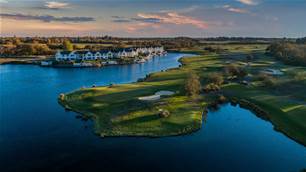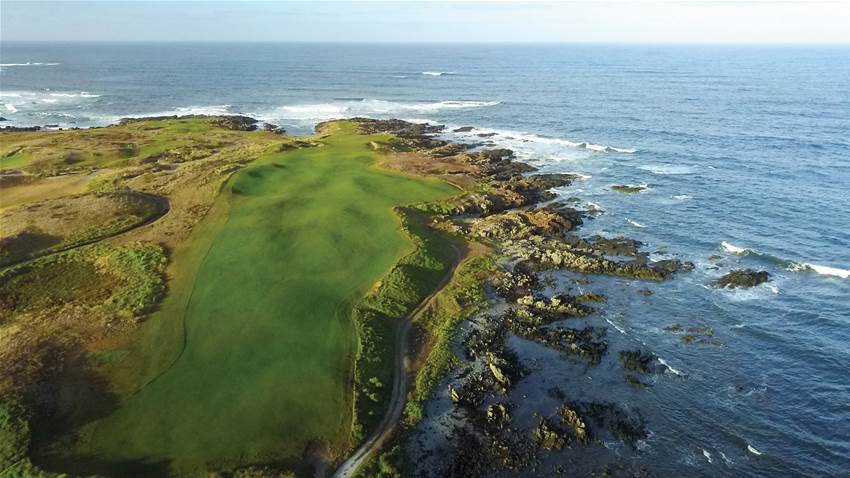Ocean Dunes is among the finest public access courses in Australia and for good reason. It boasts inspiring ocean views and amazing holes that will have you yearning for more.
There is something about playing golf by the sea that is invigorating for any golfer. The sound of crashing waves, incredible views and the distinctive ocean air in your lungs add to the thrill of playing the game, no matter how good or bad you are.
Few courses in Australia get you closer to the sea for longer during a round than Ocean Dunes – a Graeme Grant-designed layout, which is just a few minutes’ drive north of Currie on the west coast of picturesque King Island.
The par-72 covers dramatic golfing terrain with fairways that weave over and between huge sand dunes, with a third of its holes playing along or down to its two-kilometre stretch of ocean frontage.
The capricious nature of this Bass Strait location – no land mass to the west on the same latitude until you hit Argentina nearly 11,000 kilometres away – gives Ocean Dunes a Dr Jeykll and Mr Hyde persona. It can be peaceful, placid and highly scoreable; then, sometimes within a handful of hours, the wind will pick up and turn this beauty into a brute.
Hence, choosing the appropriate tee markers (there are four options) to suit the daily conditions and your ability is well advised. That said, Grant’s design takes any challenging conditions into account with generously wide fairways and large greens.

Another highlight of Grant’s design is it allows the golfer freedom to play their ball close to the ground (a necessity some days). For those of us that find the game far more interesting when the ball is bouncing rather than flying high through the air, Ocean Dunes is a Godsend. There are a few holes that demand an aerial route (like the shoreline carries at the par-3 4th and 10th), but on the whole you have the option to go high or low on every shot you face.
The opening hole – a dogleg right 500-metre par-5 – leads you on a rollercoaster ride over dunes and down to a green seemingly lying within metres of lapping waves. Standing at the crest of the hill on the corner of the dogleg, the view is inspiring. Welcome to Ocean Dunes.
It doesn’t take long into a round for the excitement to really grow. Good quality short par-4s thrill all golfers and Ocean Dunes’ 280-metre 2nd hole is already being compared with some of the best two-shotters in Australia.
It is a wide driving hole but the green only opens up to those players prepared to risk placing their drives near the right edge of the fairway and the ‘Kelp Track’, which weaves along the shoreline. The further left you go, the more difficult the second shot approach becomes as it is a blind pitch over a bunker carved out of the face of a large dune. If your drive is too far left on a day when the flag is in the left half of the green, you will have no idea where the hole is as it will be hidden behind the dune. It is a pitch shot that is reminiscent of what golfers face on the famed ‘Dell’ hole at Lahinch in Ireland – it’s blind, over a large dune to a green that is 45 metres wide and 10 metres at its deepest.

The 2nd is a great example of what Ocean Dunes offers in spades – breathtaking views combined with unforgettable strategic holes that ask questions of every shot you are faced with during the round.
Ocean Dunes’ first long par-4 follows at the 3rd. Known as ‘Old Track’ it measures 425 metres from the tips and features a big, wide fairway, which you will be thankful for if you happen to play on a day when the wind is whipping in from the south. It is long, but the firm playing surfaces do assist, especially if you are accurate with all the clubs in your bag. The wide opening – between two deep bunkers – to the 3rd green can be easily navigated with a 3-wood or hybrid, especially from the left half of the fairway.
One of the shortest holes at Ocean Dunes is already the most talked about, and for good reason. The 130-metre par-3 4th hole is played across an ocean inlet with rocky edges on both sides of the water. The tee is perched just above the waves, while the expansive putting surface is very wide and features a bunker cut into the middle of the front edge. This pinches the target to its narrowest and has the effect of almost creating two greens, left and right of the bunker.

A crop of pigface lying between the rocks and the grass short of the green flowers pink in spring and summer, adding to the beauty of this spectacular one-shotter. While the 4th hole will be reached with a short club on most days, there will be times when the elements will conspire to make this diminutive offering a real beast. Ah … the joys of links golf.
Rivalling the 4th for jaw-dropping visual appeal is the long par-3 10th. With Southern Ocean waves lapping against the rocks just a few metres from your spot on the tee, you look across a small bay to spot the green 200 metres away. It’s a daunting tee shot but one you will relish trying to successfully make. I suggest taking aim at the two bunkers right of the green with a club that will carry about 180 metres. Strike it well and the ball will feed left towards the green and, if you get a good links bounce, you might just get a shot making a birdie.
The course turns inland from the par-5 12th and into an area of the course where the final holes constructed required more earthmoving. It is testament to the design that these inland holes are as interesting and challenging as the holes by the water.

My favourite is the wee 14th hole – a 115-metre downhill par-3 where the tee is perched high above the long, narrow green on one of the most exposed areas of the course. Up here there is no hiding from the wind and the shuddering thought of hitting your ball up into the wind and not knowing where it will finish – sand left and short or deep fescue grass to the right and long. If you do happen to hit the green, the fun doesn’t stop there, as you negotiate the dramatically sloping putting surface.
Every golfer who has played Ocean Dunes since it opened in 2016 has no doubt played Cape Wickham Links, 40 minutes’ drive to the north. I’ve been lucky enough to play both courses several times during the past few years and it is unfair to compare one with the other as the only thing they really have in common are their seaside locations. Each design reflects the terrain it lies on so the golfing experience is different, but brilliantly unforgettable, for both.
THE COURSE
LOCATION: Main St, Currie, King Island, Tasmania. Ocean Dunes is a 10-minute drive from King Island Airport at Currie.
CONTACT: (03) 6462 1633.
WEBSITE: www.oceandunes.com.au
DESIGNER: Graeme Grant (2016).
PLAYING SURFACES: Bentgrass (greens), fine fescue (fairways and tees).
COURSE SUPERINTENDENT: Martin Rose.
GREEN FEE: $175.
THE LOCATION
GETTING THERE: Flights to King Island operate from the rest of Tasmania and Melbourne (from Tullamarine, Essendon and Moorabbin airports) via several airlines, including Regional Express, Vortex Air, Sharp Airlines, Kirkhope Aviation and King Island Airlines. Various tour package providers also include King Island in their golf holiday offerings.
ACCOMMODATION: Ocean Dunes also operates the King Island Hotel at Currie. The 13 beautifully modern decorated rooms are available as twin, double or a mixture of both, plus two connecting rooms for larger groups or families. Room facilities include Wi-Fi, TV, bar fridge, hair dryer, plus tea and coffee-making facilities.
ACCOLADES: Ocean Dunes was ranked at No.4 in Golf Australia’s list of the Top-100 Public Access Courses in Australia for 2019. It also debuted at No.8 in this magazine’s Top-100 Courses ranking in 2018.
Related Articles

Review: Omaha Beach Golf Club

Course Review: Cape Kidnappers













